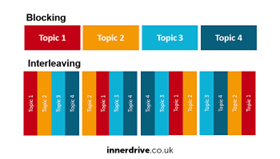Blog
Pain *is* gain: Strategies to facilitate desirable difficulties
By Janzen Harding, Instructor
As educators, we should make learning as easy and straightforward as possible, right?
Actually, no, according to research.
Experts have actually found that incorporating certain practices which slow down and seemingly hinder learning can improve long-term memory retention. Just like adding weights to a barbell (which makes weightlifting more challenging) results in stronger muscles, adding difficulty to the learning process results in stronger memory retention in the long-term.
This concept, known as desirable difficulties, is the idea that people learn more effectively when they are sufficiently challenged in the learning process. While students may understandably shy away from intentionally making the learning process more difficult, studies have shown that the long-term results produced by desirable difficulties can outweigh traditional efforts by 40%! Further, desirable difficulties ultimately enhance executive function skills, like the ability to manage information, prioritize tasks, and switch gears effectively – all of which are essential for navigating complex learning environments and beyond.
So how can students incorporate desirable difficulties without getting frustrated and giving up? What is the right amount of difficulty? Here are three ways students can engage with desirable difficulties when it comes to studying:
- Spacing is the idea that you should spread out your studying across multiple study sessions rather than cramming it all in the night before the test (the latter is known as massed practice). Massed practice can feel effective to students, especially if they engage in it right before an assessment, but it does not facilitate moving information into long-term memory. Studies show that rates of information retrieval are consistently and substantially better for those who space their studying than those who use massed practice. Research also indicates that spacing should be proportional to the amount of time between studying and the assessment. For more on spacing, see our blog post on spaced studying.
- Interleaving is perhaps the most counterintuitive desirable difficulty to practice while studying. Traditionally, concepts are taught according to category, so there is clear separation between topics. For example, in a math class, students might be expected to master addition problems before moving onto subtraction problems. Interleaving,
 on the other hand, is when topics and concepts are studied together and in random, less predictable patterns. Introducing randomness to the otherwise clear-cut categories is part of what makes this desirable difficulty so, well, difficult! So, instead of block practicing a dozen of the same type of problems, interleaving would call for practicing various types of problems in the same session. Furthermore, Research shows that interleaving not only improves long-term retention, but also inductive learning!
on the other hand, is when topics and concepts are studied together and in random, less predictable patterns. Introducing randomness to the otherwise clear-cut categories is part of what makes this desirable difficulty so, well, difficult! So, instead of block practicing a dozen of the same type of problems, interleaving would call for practicing various types of problems in the same session. Furthermore, Research shows that interleaving not only improves long-term retention, but also inductive learning! - Self-testing enhances the skill of memory recall. Oftentimes, students will re-read notes and feel like they’ve sufficiently studied the material. However, studies indicate that the effort of generating an answer to a question or actively retrieving information from memory is much more effective than simply looking back over the material itself. Contrary to popular belief, our brains do not work like cameras which can automatically store and save information (unless you are gifted with a photographic memory!). Instead, our brains work like filing systems, and self-testing is the practice of retrieving stored information; the more practice you have with searching through memory filing systems, the better job you will do at retrieving that information when you need to. Self-testing can look like:
-
-
-
- Creating flashcards (Quizlet is a popular online resource)
- Trying practice tests (or answering questions from a previous assessment)
- Having a partner quiz you on the material
- Quizzing yourself by covering information/solutions and doing your best to supply the answer
-
-
Incorporating desirable difficulties like spacing, interleaving and self-testing into study practices can significantly improve long-term learning and outcomes. Desirable difficulties might require more initial effort and engage executive function skills like planning, organization, and time management, the long-term benefits in memory and understanding far outweigh the short-term challenges. These practices strengthen the cognitive muscles responsible for learning, just like physical exercise strengthens physical muscles. Once students understand that in this particular scenario, pain is gain, they may be more apt to adopt desirable difficulties into their practice, so helping them understand how desirable.

